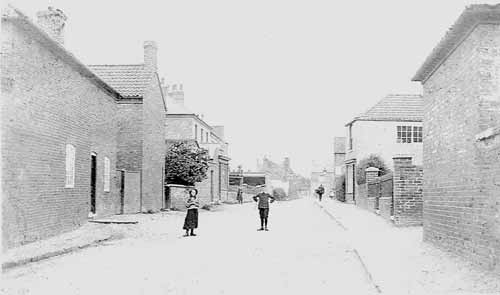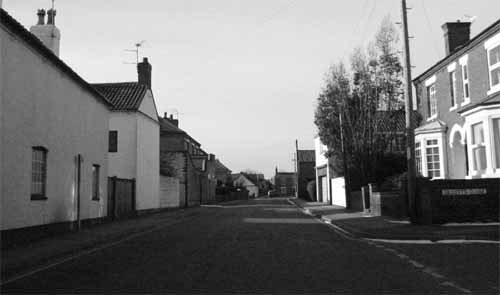![]()
Newgate Street looking west from Gillott’s Close junction

c.1900

2003
The first building on the left of these pictures is No. 3, Close Acre and was possibly a farmhouse. Since 1900, the front door opening straight onto the street has been bricked up. The opening between this and Mary Cottage, No. 5 with a gable end onto the street, was apparently not gated in 1900,or possibly the gates were set further back, giving access into the yard at the rear. Beyond No. 5 is now a high stone wall where previously there was an opening, low wall and front garden leading to the original entrance to No. 5. The bushes obscure a brick lean-to structure that is clearly seen in the 2003 photograph. Before Eaton Place was built, the Bingham Library occupied the lean-to building for several years. This area ‘No. 7’ is now part of the property of No.9, one of a pair of Victorian villas, with No. 11, built in 1897. No.9 incorporated Sheldon Marson’s tailor’s shop that later in the 1900s was rented to a Draper, Ethel Ingram. The shop front seen in c.1900 was removed in the 1960s. Beyond this, there is a low wall and piers with railings and out-buildings surrounding a yard. This is Walter Wilson’s builder’s yard who certainly built No.11 and probably No.9. Then, at the point where today the entrance to the town car park is located, both pictures show a similar white gable end that has changed little. The large farmhouse on the corner with Fairfield Street, has been replaced by bungalows.
Looking at the north side, the pair of bay-fronted villas, Nos. 14 & 12, must have existed when the c.1900 photograph was taken but from this viewpoint they are completely hidden by the building in the right foreground. This was part of the property run by tenant farmer, Gillott and was demolished to build Gillott’s Close, on the land he had farmed, in the 1960s. All we can see on the old picture to indicate the presence of Nos. 12 & 14, are the front garden walls, railings and brick piers which, apart from losing the railings, are basically unchanged. The next structure is No. 18, a stocking frame knitters’ workshop and house with the distinctive large windows required by this trade. Replacement window frames have been installed and can just be seen through the trees. The shop front window and doorway into the building at street level in the 1930s was Oliver Fiddies plumbers and has now become a garage. This was originally part of No.16, a cottage that lies back from the road. Further on is the barn dated 1862 which is part of the cottage, No. 20, which is also back off the road and out of sight. Finally, in the distance can be seen the outline of Kirkland House
We are left, in the c.1900 picture, with one unexplained single-storey building that can be seen in School Lane, to the left of Kirkland House. This does not appear on maps of the period, but must be sited where, in the 2003 photograph, the gardens of post-war housing in School Lane can be seen from this viewpoint.
